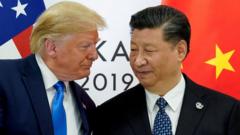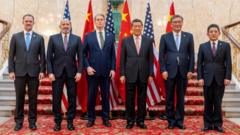A brief analysis of the recent talks highlights the importance of collaboration between the nations amidst ongoing economic tensions.
**U.S.-China Trade Agreement Reached After Intensive Talks**

**U.S.-China Trade Agreement Reached After Intensive Talks**
After two days of negotiations, the U.S. and China have reportedly finalized a new trade agreement during a summit in London.
Following two days of intense discussions in London, President Trump announced a preliminary U.S.-China trade agreement, indicating that the countries will roll back certain economic restrictions previously imposed. This agreement marks a significant moment after months of escalating tensions that began with tariffs announced by the Trump administration in April.
Key points from the deal suggest that China intends to ease its limitations on exports of crucial rare earth minerals and magnets, which are vital for various American industries. In turn, the U.S. will forego imposing visa restrictions on Chinese students while also lessening constraints on a number of its exports. However, the specifics of the agreement remain limited, fueling ongoing curiosity and speculation around its broader implications.
On his preferred social media platform, Trump declared, “OUR DEAL WITH CHINA IS DONE, SUBJECT TO FINAL APPROVAL WITH PRESIDENT XI AND ME. RELATIONSHIP IS EXCELLENT!” His comments reflect an optimistic outlook on U.S.-China relations, despite the acknowledgment that some tariffs will stay in effect.
The U.S. and China have been under pressure from businesses and consumers alike due to the uncertainty surrounding trade tariffs and the risk of decreased availability of goods in the U.S. market. As the current 90-day pause on certain tariffs approaches its conclusion in August, stakeholders are closely monitoring the situation for further developments.
Experts suggest the terms of this new agreement primarily serve to reverse some of the prior escalations from the trade conflict rather than paving the way for groundbreaking advancements in the long-term trade relationship. Ana Swanson, a trade and economics reporter, highlighted this perspective, noting that without further arrangements, the agreement might not indicate a substantial shift in trade practices between the nations going forward.
Key points from the deal suggest that China intends to ease its limitations on exports of crucial rare earth minerals and magnets, which are vital for various American industries. In turn, the U.S. will forego imposing visa restrictions on Chinese students while also lessening constraints on a number of its exports. However, the specifics of the agreement remain limited, fueling ongoing curiosity and speculation around its broader implications.
On his preferred social media platform, Trump declared, “OUR DEAL WITH CHINA IS DONE, SUBJECT TO FINAL APPROVAL WITH PRESIDENT XI AND ME. RELATIONSHIP IS EXCELLENT!” His comments reflect an optimistic outlook on U.S.-China relations, despite the acknowledgment that some tariffs will stay in effect.
The U.S. and China have been under pressure from businesses and consumers alike due to the uncertainty surrounding trade tariffs and the risk of decreased availability of goods in the U.S. market. As the current 90-day pause on certain tariffs approaches its conclusion in August, stakeholders are closely monitoring the situation for further developments.
Experts suggest the terms of this new agreement primarily serve to reverse some of the prior escalations from the trade conflict rather than paving the way for groundbreaking advancements in the long-term trade relationship. Ana Swanson, a trade and economics reporter, highlighted this perspective, noting that without further arrangements, the agreement might not indicate a substantial shift in trade practices between the nations going forward.























